.
15.08.2015
ASTEROIDS AT THE “PHOTO FINISH”
Today's Gaia blog post is contributed by Paolo Tanga, Associate Astronomer at the Observatoire de la Côte d’Azur, Nice (France).
We tend to think that a still picture, shot with an ordinary camera, represents a subject at a given time. But this is not always the case. In some situations, a picture can show the evolution in time of the depicted subject. This is the case, for example, of the well-known “photo finish” technique widely used in athletics to record the competing athletes as they cross the arrival line at the end of the race.
How does it work? Simply, the camera aims only at a vertical strip containing the finish line and repeatedly photographs it at high speed. By putting all the strips together side-by-side, one can obtain the evolution of the image of the finish line as a function of time. As weird as it may sound, the CCD camera onboard Gaia works exactly the same way – by transforming the recorded star positions into times, the finish line being a thin strip of pixels on the edge of the detector.
Let’s imagine that we are looking at a number of athletes all running at the same speed on a straight track, but each of them having started the race at a different time: in this analogy, these are the stars, which drift across the Gaia telescopes all at the same velocity – given by the constant rotation of the satellite. If Gaia observes them several times, they will always appear spaced by the same delays.
Now, let’s add to these well-behaved competitors a different type of athlete, a rebel one who's not playing by the rules, always running either much faster or much slower than the others, and not following the direction of the track lanes but drifting as he/she pleases. Each time this eccentric athlete crosses the finish line, it will be in a different position relative to the competing runners. This is how an asteroid appears to Gaia, as its motion relative to stars makes it appear always in a different position, as a function of the time at which it is observed.
This unorthodox behaviour opens up a specific category of problems when dealing with asteroid observations. The first one is predicting when – and where – Gaia will observe a given object. In practice, it’s like predicting in advance the delays of the eccentric athlete relative to the others, when on the finish line. To perform this computation, we need to have an exact knowledge of its trajectory (the orbit of the asteroid), along with the precise speed of the “ordinary” competitors (the stars). In the case of Gaia, all these pieces of information are known, but the complexity of the scanning law, which displaces the “arrival line” in non-trivial patterns, makes the task extremely delicate. Besides, there are several “finish lines” on the Gaia focal plane (at least one per CCD), so the whole geometry of the system plays a role.
The second type of problem concerns the processing of asteroid observations, especially in the case of newly detected asteroids or of asteroids whose orbit is not yet known to great precision. In fact, each time the asteroid crosses the “finish line” it will be in a different region of the sky. Only observations that are close in time can be easily linked together, as the asteroid displacement relative to its background will be small. If the observations are performed over longer time spans, the presence of several such “rebel runners” can make things extremely complex.
.
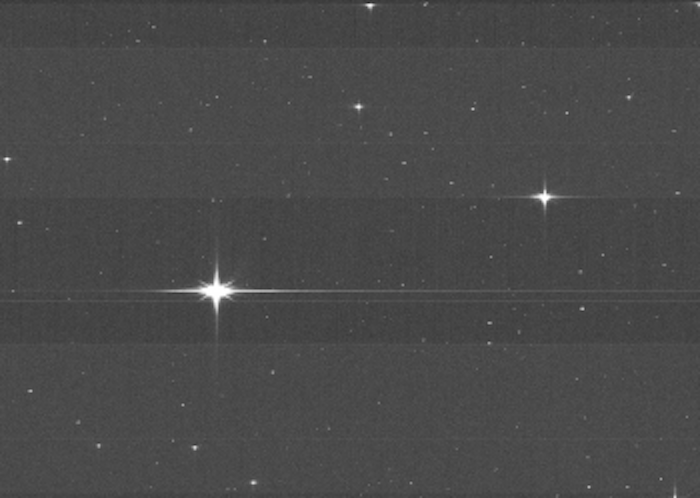
These various aspects are illustrated in the following pictures. The first one (right) is a test image of the asteroid (54) Alexandra, a bright moving target. It was obtained by programming Gaia in a special imaging mode. As described before, this is a “photo finish” image. It was reconstructed by moving along the horizontal axis, which is equivalent to the observer moving in time: each pixel column represents the signal present on the “finish line” (in practice: the edge of the CCD) at a given moment. In the image, the time delay between the arrival at the finish line of the bright star and the asteroid is about 1.26 seconds. A very accurate timing of each source “arrival” is the basis of the extraordinary astrometric capabilities of Gaia.
More important, however, is the fact that in this image the predicted position of the asteroid is very close to the observed one, only a few pixels away. Given the computational difficulties involved in this process, this is an achievement with important consequences, such as the possibility to predict well enough very close “encounters” between a star and an asteroid on the plane of the sky – these are potential sources of confusion while searching for other types of anomalies (when monitoring the brightness of a star, for example). Many astronomers want to be alerted when an interesting change occurs, not when an asteroid is just passing by!
On the other hand, other astronomers (planetary scientists!) are interested in the asteroids themselves. In fact, Gaia will observe 350,000 asteroids, providing the richest sample of precise orbits and physical properties that we could dream of. Those rebel runners, containing clues about the Solar System's formation, are really interesting, and come in large quantities. Our capability to track their position is essential in the identification process.
.
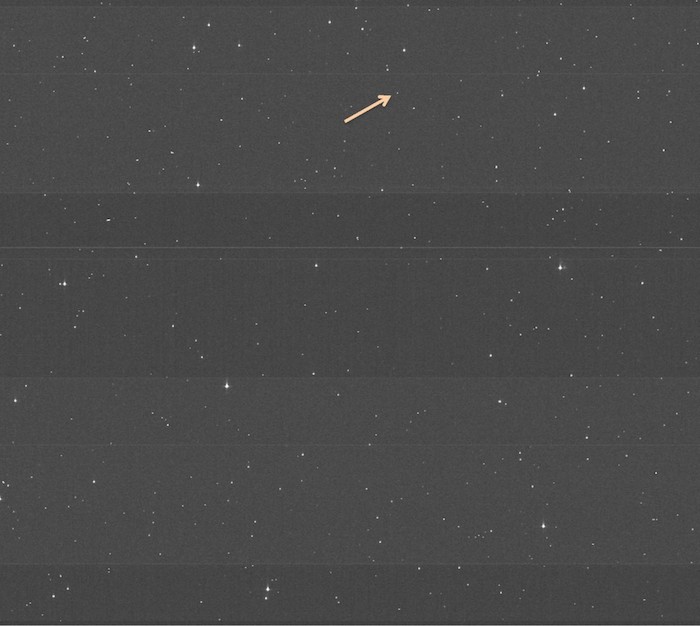
The case of the asteroid (4997) Ksana (above) is more difficult, and showcases the capabilities of Gaia in detecting and identifying asteroids. Because it is very faint, it may have been confused with several stars – some not even present in current catalogues – making its identification more ambiguous. The presence of a source very close to the position where the asteroid was predicted to be is very encouraging, but only a comparison of data acquired over time can provide a confirmation.
.
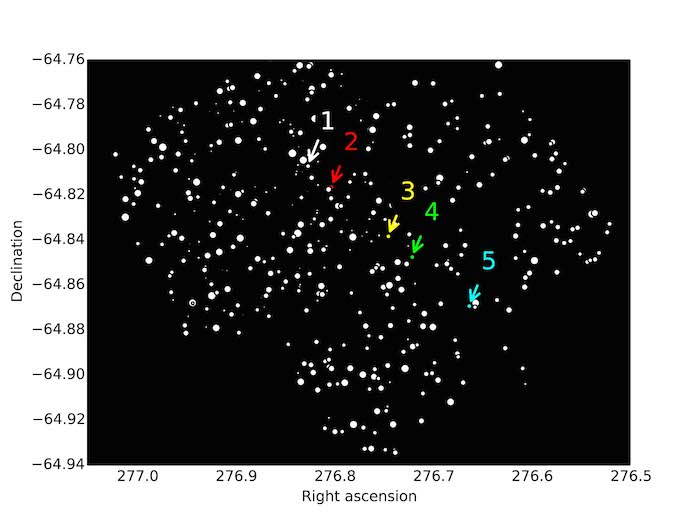
The result is shown in (left), which represents an intermediate product of the processing itself: the preliminary positions of the sources seen by Gaia, as determined by the “Initial Data Treatment”. In these images, each point is a source and the point size is proportional to the source's brightness. Different colours represent the stars observed during five different sweeps of the same sky region, each lasting 6 seconds, by a single CCD.
The asteroid (4997) Ksana is now clearly seen moving from one sweep to the next (as indicated by the arrows). Checking the presence and motion of the object at the corresponding epoch provides a secure confirmation of its nature. A final remark: the observations are not equally spaced in time, and the closer couple of detections correspond to the source passing through the two telescopes (106 minutes apart) while the satellite rotates. A full rotation of the satellite (every 6 hours) separates the two detections in each pair.
Gaia asteroid observations will be processed using the software pipeline designed and implemented by Coordination Unit 4 of the DPAC, running at the CNES processing centre (Toulouse, France).
The data presented here are extracted from the results obtained by the Initial Data Treatment (IDT) pipeline, which was largely developed at the University of Barcelona and runs at the Data Processing Centre at ESAC.
---
GAIA DISCOVERS ITS FIRST SUPERNOVA
While scanning the sky to measure the positions and movements of stars in our Galaxy, Gaia has discovered its first stellar explosion in another galaxy far, far away.
.
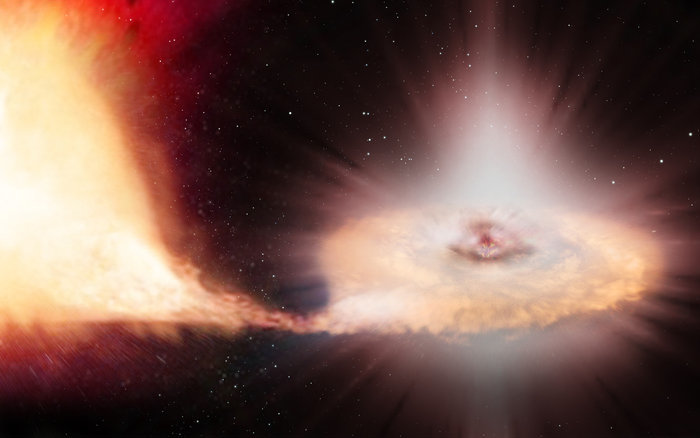
This powerful event, now named Gaia14aaa, took place in a distant galaxy some 500 million light-years away, and was revealed via a sudden rise in the galaxy’s brightness between two Gaia observations separated by one month.
Gaia, which began its scientific work on 25 July, repeatedly scans the entire sky, so that each of the roughly one billion stars in the final catalogue will be examined an average of 70 times over the next five years.
“This kind of repeated survey comes in handy for studying the changeable nature of the sky,” comments Simon Hodgkin from the Institute of Astronomy in Cambridge, UK.
Many astronomical sources are variable: some exhibit a regular pattern, with a periodically rising and declining brightness, while others may undergo sudden and dramatic changes.
.
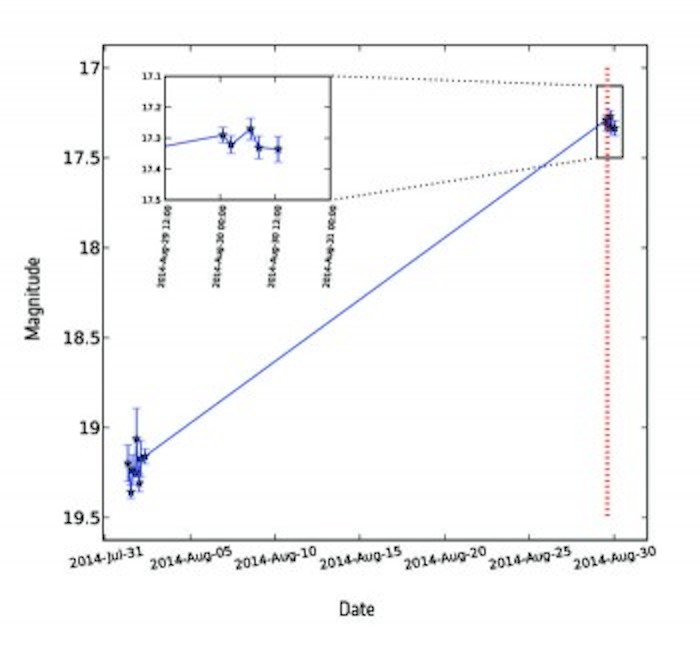
“As Gaia goes back to each patch of the sky over and over, we have a chance to spot thousands of ‘guest stars’ on the celestial tapestry,” notes Dr Hodgkin. “These transient sources can be signposts to some of the most powerful phenomena in the Universe, like this supernova.”
Dr Hodgkin is part of Gaia’s Science Alert Team, which includes astronomers from the Universities of Cambridge, UK, and Warsaw, Poland, who are combing through the scans in search of unexpected changes.
It did not take long until they found the first ‘anomaly’ in the form of a sudden spike in the light coming from a distant galaxy, detected on 30 August. The same galaxy appeared much dimmer when Gaia first looked at it just a month before.
“We immediately thought it might be a supernova, but needed more clues to back up our claim,” explains Łukasz Wyrzykowski from the Warsaw University Astronomical Observatory, Poland.
Other powerful cosmic events may resemble a supernova in a distant galaxy, such as outbursts caused by the mass-devouring supermassive black hole at the galaxy centre.
.
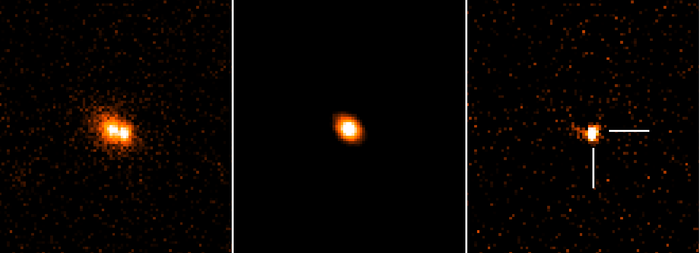
Supernova Gaia14aaa and its host galaxy
.
However, in Gaia14aaa, the position of the bright spot of light was slightly offset from the galaxy’s core, suggesting that it was unlikely to be related to a central black hole.
So, the astronomers looked for more information in the light of this new source. Besides recording the position and brightness of stars and galaxies, Gaia also splits their light to create a spectrum. In fact, Gaia uses two prisms spanning red and blue wavelength regions to produce a low-resolution spectrum that allows astronomers to seek signatures of the various chemical elements present in the source of that light.
---
COUNTING STARS WITH GAIA
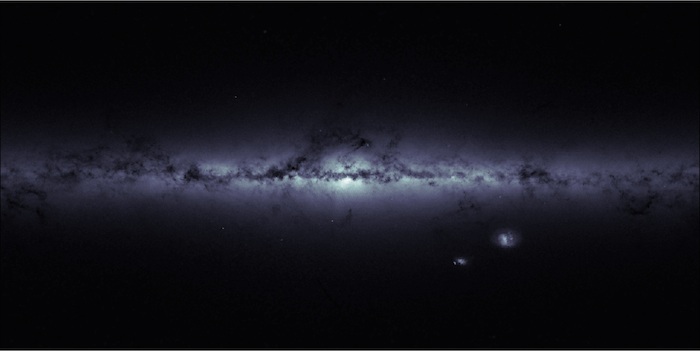
This image, based on Gaia housekeeping data, is no ordinary depiction of the heavens. While the image portrays the outline of our Galaxy, the Milky Way, and of its neighbouring Magellanic Clouds, it was obtained in a rather unusual way.
As Gaia scans the sky to measure positions and velocities of a billion stars with unprecedented accuracy, for some stars it also determines their speed across the camera's sensor. This information is used in real time by the attitude and orbit control system to ensure the satellite's orientation is maintained with the desired precision.
These speed statistics are routinely sent to Earth, along with the science data, in the form of housekeeping data. They include the total number of stars, used in the attitude-control loop, that is detected every second in each of Gaia's fields of view.
It is the latter – which is basically an indication of the density of stars across the sky – that was used to produce this uncommon visualisation of the celestial sphere. Brighter regions indicate higher concentrations of stars, while darker regions correspond to patches of the sky where fewer stars are observed.
The plane of the Milky Way, where most of the Galaxy's stars reside, is evidently the brightest portion of this image, running horizontally and especially bright at the centre. Darker regions across this broad strip of stars, known as the Galactic Plane, correspond to dense, interstellar clouds of gas and dust that absorb starlight along the line of sight.
The Galactic Plane is the projection on the sky of the Galactic disc, a flattened structure with a diameter of about 100 000 light-years and a vertical height of only 1000 light-years.
Beyond the plane, only a few objects are visible, most notably the Large and Small Magellanic Clouds, two dwarf galaxies orbiting the Milky Way, which stand out in the lower right part of the image.
A few globular clusters – large assemblies up to millions of stars held together by their mutual gravity – are also sprinkled around the Galactic Plane. Globular clusters, the oldest population of stars in the Galaxy, sit mainly in a spherical halo extending up to 100 000 light-years from the centre of the Milky Way.
The globular cluster NGC 104 is easily visible in the image, to the immediate left of the Small Magellanic Cloud. Other globular clusters are highlighted in an annotated version of this image.
Interestingly, the majority of bright stars that are visible to the naked eye and that form the familiar constellations of the sky are not accounted for in this image because they are too bright to be used by Gaia's control system. Similarly, the Andromeda galaxy – the largest galactic neighbour of the Milky Way – also does not stand out here.
Counterintuitively, while Gaia carries a billion-pixel camera, it is not a mission aimed at imaging the sky: it is making the largest, most precise 3D map of our Galaxy, providing a crucial tool for studying the formation and evolution of the Milky Way.
Acknowledgement: this image was prepared by Edmund Serpell, a Gaia Operations Engineer working in the Mission Operations Centre at ESA's European Space Operations Centre in Darmstadt, Germany
---
GAIA SATELLITE AND AMATEUR ASTRONOMERS SPOT ONE IN A BILLION STAR
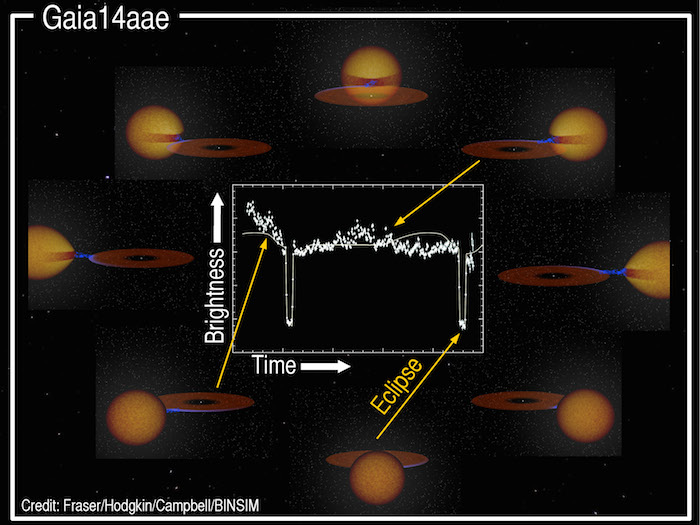
The Gaia satellite has discovered a unique binary system where one star is 'eating' the other, but neither star has any hydrogen, the most common element in the Universe. The system could be an important tool for understanding how binary stars might explode at the end of their lives.
An international team of researchers, with the assistance of amateur astronomers, have discovered a unique binary star system: the first known such system where one star completely eclipses the other. It is a type of two-star system known as a Cataclysmic Variable, where one super dense white dwarf star is stealing gas from its companion star, effectively 'cannibalising' it.
The system could also be an important laboratory for studying ultra-bright supernova explosions, which are a vital tool for measuring the expansion of the Universe. Details of the new research will be published in the journal Monthly Notices of the Royal Astronomical Society.
The system, named Gaia14aae, is located about 730 light years away in the Draco constellation. It was discovered by the European Space Agency's Gaia satellite in August 2014 when it suddenly became five times brighter over the course of a single day.
Astronomers led by the University of Cambridge analysed the information from Gaia and determined that the sudden outburst was due to the fact that the white dwarf – which is so dense that a teaspoonful of material from it would weigh as much as an elephant – is devouring its larger companion.
Additional observations of the system made by the Center for Backyard Astrophysics (CBA), a collaboration of amateur and professional astronomers, found that the system is a rare eclipsing binary, where one star passes directly in front of the other, completely blocking it out when viewed from Earth. The two stars are tightly orbiting each other, so a total eclipse occurs roughly every 50 minutes. The follow-up campaign was also using many professional telescopes, among others the ones located in the Canary Islands, where observing time was made available through the International Time Program.
"It's rare to see a binary system so well-aligned" said Dr Heather Campbell of Cambridge's Institute of Astronomy, who led the follow-up campaign for Gaia14aae. "Because of this, we can measure the system with great precision in order to figure out what these systems are made of and how they evolved. It's a fascinating system – there's a lot to be learned from it."
Using spectroscopy from the William Herschel Telescope in the Canary Islands, Campbell and her colleagues found that Gaia14aae contains large amounts of helium, but no hydrogen, which is highly unusual as hydrogen is the most common element in the Universe. The lack of hydrogen allowed them to classify Gaia14aae as a very rare type of system known as an AM Canum Venaticorum (AM CVn), a type of Cataclysmic Variable system where both stars have lost all of their hydrogen. This is the first known AM CVn system where one star totally eclipses the other.
"It's really cool that the first time that one of these systems was discovered to have one star completely eclipsing the other, that it was amateur astronomers who made the discovery and alerted us," said Campbell. "This really highlights the vital contribution that amateur astronomers make to cutting edge scientific research."
AM CVn systems consist of a small and hot white dwarf star which is devouring its larger companion. The gravitational effects from the hot and superdense white dwarf are so strong that it has forced the companion star to swell up like a massive balloon and move towards it.
The companion star is about 125 times the volume of our sun, and towers over the tiny white dwarf - which is about the size of the Earth. This is similar to comparing a hot air balloon (companion) and a marble (white dwarf). However, the companion star is lightweight, weighing in at only one percent of the white dwarf's mass.
"This is an exquisite system: a very rare type of binary system in which the component stars complete orbits faster than the minute hand of a clock, oriented so that one eclipses the other." said Prof. Tom Marsh of the University of Warwick. "We will be able to measure their sizes and masses to a higher accuracy than any similar system; it whets the appetite for the many new discoveries I expect from the Gaia satellite."
AM CVn systems are prized by astronomers, as they could hold the key to one of the greatest mysteries in modern astrophysics: what causes Ia supernova explosions? This type of supernova, which occurs in binary systems, is important in astrophysics as their extreme brightness makes them an important tool to measure the expansion of the Universe.
In the case of Gaia14aae, it's not known whether the two stars will collide and cause a supernova explosion, or whether the white dwarf will completely devour its companion first. "Every now and then, these sorts of binary systems may explode as supernovae, so studying Gaia14aae helps us understand the brightest explosions in the Universe," said Dr Morgan Fraser of the Institute of Astronomy.
"This is an awesome first catch for Gaia, but we want it to be the first of many," said the Institute of Astronomy's Dr Simon Hodgkin, who is leading the search for more transients in Gaia data. "Gaia has already found hundreds of transients in its first few months of operation, and we know there are many more out there for us to find."
The research was supported by ESA Gaia, DPAC, and the DPAC Photometric Science Alerts Team. DPAC is funded by national institutions, in particular the institutions participating in the Gaia Multilateral Agreement.
---
ASTEROIDS ALL AROUND
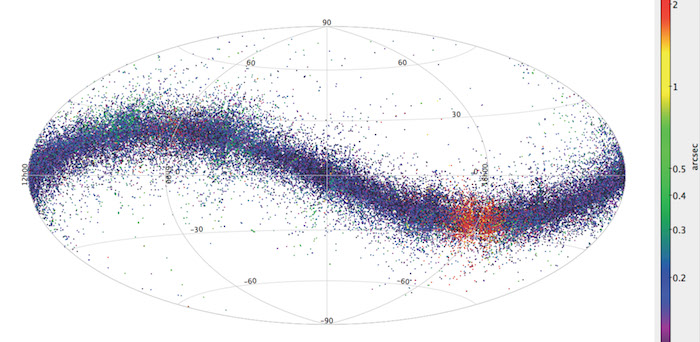
Eight months of Gaia data and a sample of 50,000 asteroids were used to test the detection efficiency of software in the Gaia processing pipeline.
Gaia observes more than a billion stars on the whole sky, without knowing in advance where they are. However, as each source is observed multiple times, the Initial Data Processing (IDT, a highly sophisticated piece of software running on the data transmitted by the satellite, developed by the University of Barcelona team) has the task of grouping together multiple observations of the same source.
This task, the so-called "cross-matching", involves comparing the positions recorded by Gaia. If two sources are observed, within the uncertainty, at the same position on the sky they are recognized to be – in fact – the same source.
For asteroids, this cannot work, as they are always moving amongst the stars - slowly (typically, an asteroid in the Main Belt can take a couple of days to move a distance of a Moon diameter) but fast enough for Gaia (several pixels during a single transit on the focal plane)! As a result, Gaia never sees an asteroid at the same place, and the cross-matching described above leaves these detections as "orphans" that do not repeat over time.
Such "un-matched" observations are processed by software running at the CNES data processing center (in Toulouse, France), written by several European astronomers under the coordination of P. Tanga (Observatoire de la Côte d'Azur, France). The first task of this software is the identification of known asteroids that can proceed only by comparing the position of the "orphan" detections to the predictions provided by a specific software module. The reference data, in this case, are the known asteroid orbits (a few 100,000 objects), that are used to generate the position of all of them for any Gaia measurement of a moving source.
Such a procedure has been implemented in the processing pipeline by J. Berthier (IMCCE) and collaborators and has been applied independently (by F. Mignard and L. Galluccio, OCA, France) on eight months of Gaia data and a sample of 50,000 asteroids to test its detection efficiency and to get a flavour of the performance of asteroid identification.
The picture above is one of the results of such a test, showing where Gaia has seen asteroids on the sky. The reference frame for the plot is equatorial, implying that the ecliptic (the orbital plane of the Earth and – also – of most other Solar System objects) appears inclined with respect to the celestial equator, and follows the sinusoidal path on which the asteroids cluster. A total of 418,000 observations by Gaia, over that period, have been successfully associated to one of the asteroids of the sample, a number very close to the expectations.
The colour of the dots is related to the accuracy of the identification, in other words to the distance between the position detected by Gaia and the one predicted by the computation of the ephemerides. For most asteroids, the identification works well (the discrepancies are less than 1 arcsec) but for others – whose orbit is poorly known – identification may become tricky and requires further processing steps.
Interestingly, the plot clearly shows a region of mixed colours, very localised, where large errors seem to be more frequent. In fact, in that region, the ecliptic crosses the Galactic plane, not far from its densest parts. The high stellar density complicates the task of IDT cross-matching, and more stars there, remaining un-matched, are incorrectly considered as asteroids. Their positions correspond to some predicted asteroid positions only by chance, so that they show up with larger discrepancies. This is an expected effect of lower efficiency in extremely crowded areas of the sky, which are very limited in size.
In fact, both statistics and analysis of samples of individual objects show that Gaia is very efficient in detecting asteroids, and the whole expected population is being observed, within a few percent of the completeness at the magnitude limit of the mission.
---
DEMONSTRATING GAIA'S ASTROMETRIC POTENTIAL
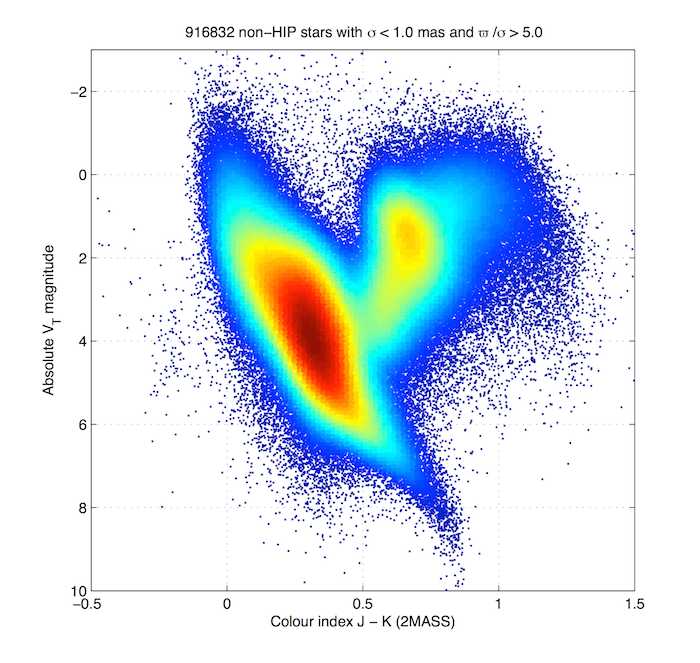
Hertzsprung-Russell diagrams based on provisional absolute parallaxes determined by the first Tycho-Gaia Astrometric Solution. Distances for stars with less than 20% (figure above) and 10% (figure below) relative parallax uncertainty (formal standard errors) were used to convert the apparent Tycho-2 magnitudes into the absolute magnitudes on the y-axis. Stars in the Hipparcos catalogue and stars with formal parallax uncertainties larger than 1 milliarcsec were omitted. Awaiting Gaia's own extensive photometric survey, the colour indices J-K on the x-axis were taken from the ground-based 2MASS catalogue. The absolute magnitudes and colour indices have not been corrected for interstellar extinction.
.
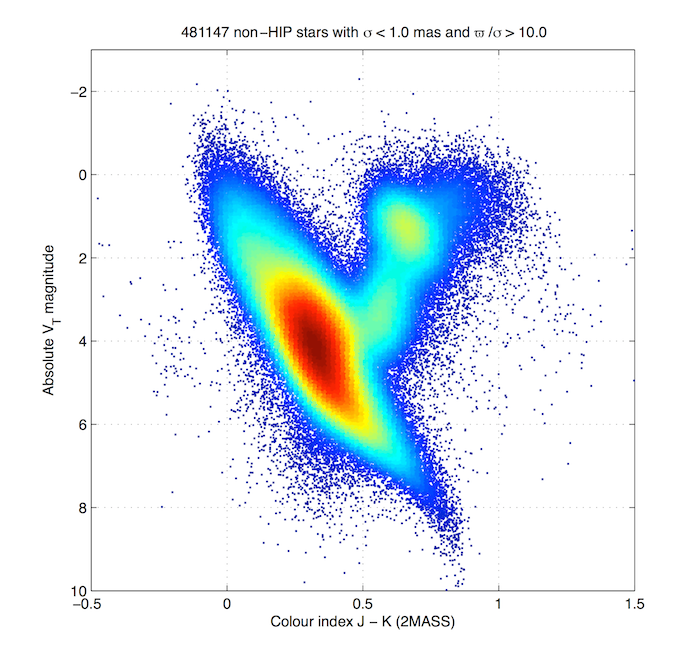
The Hertzsprung-Russell (HR) diagrams presented here were produced as part of a first validation of the astrometric capabilities of the instrument and of the Basic Angle variation measured by the on-board interferometer (Basic Angle Monitor; BAM). Based on less than one year of data from the routine observation phase of Gaia, they give an exciting hint of what the mission will deliver.
In principle the Gaia data collected until now are not yet sufficient for disentangling the parallax and proper motion of a star. However, by using an earlier-epoch position, the degeneracy can be lifted already now. For this study we used a Tycho-Gaia Astrometric Solution (TGAS; see article "The Tycho-Gaia Astrometric Solution" and A&A paper) to calculate provisional Gaia parallaxes for more than a million Tycho-2 stars. The astrometric observations were corrected for variations of the Basic Angle, as determined by the BAM. Without such a correction, the parallaxes would have been strongly biased due to the 1 mas amplitude Basic Angle variation.
Much further work is needed to prepare the data releases and to gain full confidence in the resulting astrometric parameters. Nevertheless, the above diagrams demonstrate the overall correctness and readiness of the data processing chain, the quality of the Gaia instrument, and strengthen the confidence that the impact of the Basic Angle variations can be eliminated from the final astrometric results
Quelle: ESA/Gaia/DPAC/IDT/FL/DPCE/AGIS
5059 Views
